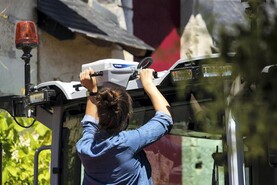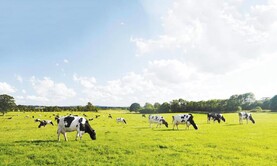Most liquid detergent sterilisers contain chlorine, which can leave chlorate residues in dairy products.
Many farmers use caustic powder on their milking machine wash and this is OK, but they need to watch what they use for washing the bulk tank.
Moving to chlorine-free means more acid washing and more hot washes. An example of a good wash routine is below.
Non-chlorine cleaning based on liquid detergent (sodium hydroxide) and an acid (phosphoric/nitric)
After each AM milking, remove or replace the milk filter sock.Wash outside of clusters and jetters. Attach jetters to clusters.Rinse plant with 14 litres (3 gals) of warm or cold water per unit.Add an approved alkaline detergent (four times per week) or acid (three times per week) at the recommended use rate in hot water at 70°C to 80°C, allowing about 9 litres (2 gals) of solution per unit.Circulate the solution for eight to 10 minutes, having allowed the first five litres to run to waste.Rinse the plant with a minimum of 14 litres (3 gals) of water per unit immediately after the wash cycle.After each PM milking, remove or replace the milk filter sock.
Wash outside of clusters and jetters. Attach jetters to clusters.Rinse plant with 14 litres (3 gals) of warm or cold water per unit.Add an approved alkaline detergent at the recommended use rate in cold water, allowing about 9 litres (2 gals) of solution per unit.Circulate the solution for eight to 10 minutes, having allowed the first five litres to run to waste.Rinse the plant with a minimum of 14 litres (3 gals) of water per unit immediately after the wash cycle. Read more
Dairy management: preparing for calving
Most liquid detergent sterilisers contain chlorine, which can leave chlorate residues in dairy products.
Many farmers use caustic powder on their milking machine wash and this is OK, but they need to watch what they use for washing the bulk tank.
Moving to chlorine-free means more acid washing and more hot washes. An example of a good wash routine is below.
Non-chlorine cleaning based on liquid detergent (sodium hydroxide) and an acid (phosphoric/nitric)
After each AM milking, remove or replace the milk filter sock.Wash outside of clusters and jetters. Attach jetters to clusters.Rinse plant with 14 litres (3 gals) of warm or cold water per unit.Add an approved alkaline detergent (four times per week) or acid (three times per week) at the recommended use rate in hot water at 70°C to 80°C, allowing about 9 litres (2 gals) of solution per unit.Circulate the solution for eight to 10 minutes, having allowed the first five litres to run to waste.Rinse the plant with a minimum of 14 litres (3 gals) of water per unit immediately after the wash cycle.After each PM milking, remove or replace the milk filter sock.
Wash outside of clusters and jetters. Attach jetters to clusters.Rinse plant with 14 litres (3 gals) of warm or cold water per unit.Add an approved alkaline detergent at the recommended use rate in cold water, allowing about 9 litres (2 gals) of solution per unit.Circulate the solution for eight to 10 minutes, having allowed the first five litres to run to waste.Rinse the plant with a minimum of 14 litres (3 gals) of water per unit immediately after the wash cycle. Read more
Dairy management: preparing for calving






 This is a subscriber-only article
This is a subscriber-only article









SHARING OPTIONS: